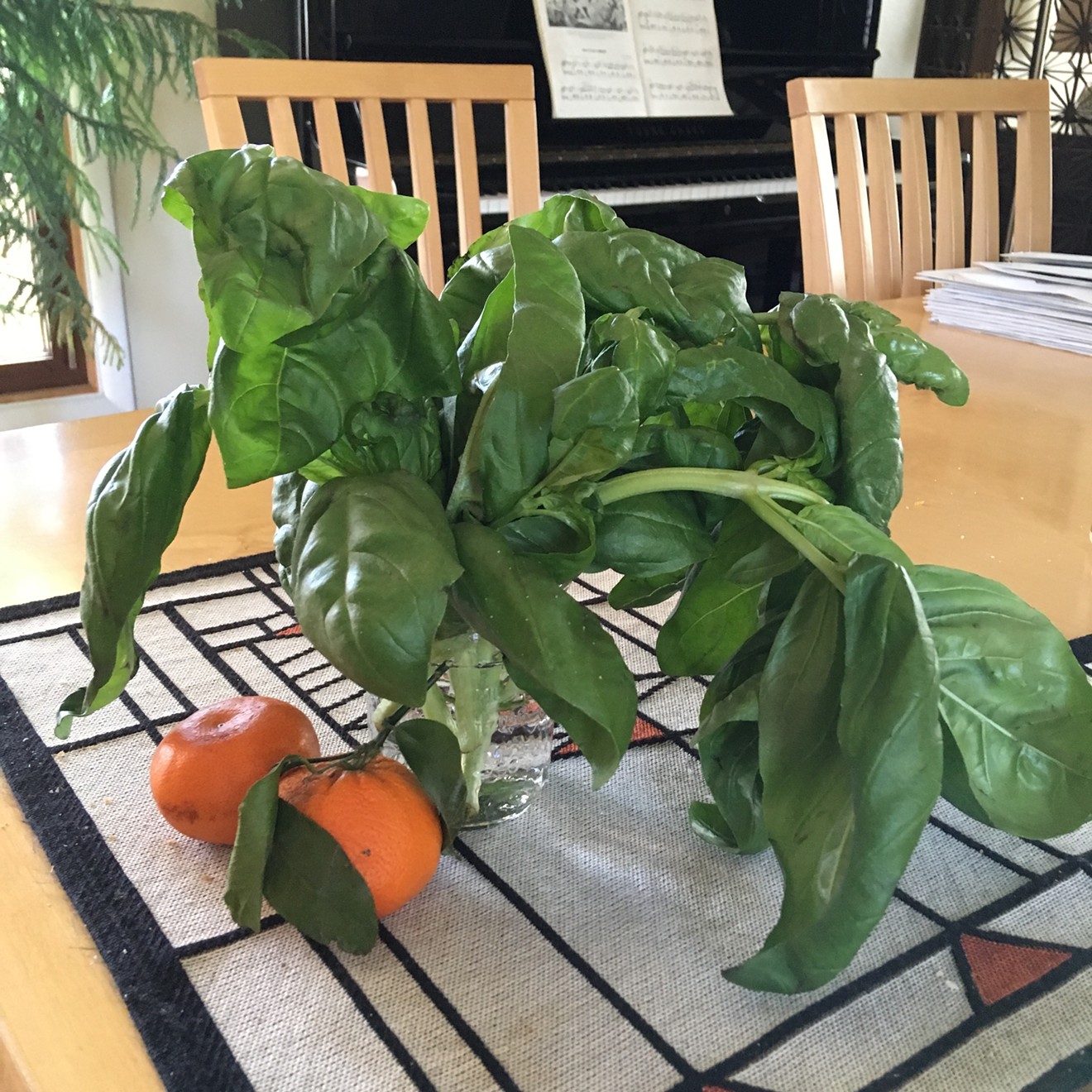The weather is freezing as vendors set up in the early hours of Saturday morning for the very first Boulder Farmers Market of the year, but the sun warms the scene as the hours go by. Familiar stalls line 13th Street between Arapahoe Avenue and Canyon Boulevard — the Boulder Art Museum and Dushanbe Teahouse on one side, Central Park on the other. There will be regular markets now every Saturday from 8 a.m. to 2 p.m. until November 17, and on Wednesdays between 4 and 8 p.m. beginning May 2 and ending October 3.
Although the growing season is young, there’s already a fine variety of produce on offer: carrots, potatoes, winter squashes and radishes that were stored during the winter but are still more flavorful than most of what you’ll find in the stores; spinach over-wintered in the fields (new spring spinach will arrive soon); greenhouse tomatoes (including heirloom), cucumbers and, wonder of wonders, basil as Italian-summer fragrant as any you’ll find later in the year. Full heads of lettuce grown in greenhouses are sold living with raffia-bound roots, and bags of bright young leaves — mizuna and arugula — are also available. Aspen Moon has three kinds of heritage flour, which I promise myself to experiment with, and cornmeal that will give your cornbread a deep, persuasive flavor. Hazel Dell is here with exquisitely fresh mushrooms — cremini, lion's mane, oyster, shiitake and my favorite, the royal trumpets. You don’t have to wash these before cooking because they’re grown on sterilized peat — just brush them off with a paper towel or kitchen brush.
There are meats, too, of course, though Bob and Ellen Stocker of El Regalo Ranch have left the regular Saturday markets (too exhausting, they explained in an email to customers) and set up shop for their succulent and not remotely funky goat meat in Niwot. You can find them in the parking lot of My Mom’s Pie (201 Murray Street) the first Saturday of May and June from 11 a.m. until 12:30 p.m. If you’re lucky, Bob will have brought his home-cooked samples: goat stew meat, kabobs and ribs, all deeply delicious.
At the market itself, Frank Silva is back with pork and his Natural Homestead Beef. If you have any qualms about eating meat, CAFOS or cruelty to animals, you’ll be glad to know that this man loves his highland cattle, names many of them, and tends them through the life cycle with care. The hens at Jodar Farms never see those stacked wire cages or suffocate on the filthy floors of huge sheds, either. The birds at Wisdom’s Natural Poultry are also ethically raised. For lamb, get on the email list for Triple M Bar Ranch and you’ll see how carefully David and Mary Miller tend to the birthing and care of their charges; you’ll also get photos of the magnificent white Great Pyrenees mountain dogs that guard their sheep from mountain lions and coyotes.
There’s also bison from SunRise Bison Ranch. For cured meats, Denver’s Il Porcellino Salumi showed up for the Wednesday markets last year and is a welcome addition on Saturdays this year.
It wouldn’t be the Saturday market if Tim Brod weren’t here loudly hawking his gorgeous Highland Honey. He’s evangelical about bees and honey, and has provided half the county's beekeepers with their queens, as well as advice.
I’m currently reading The Diet Myth: The Real Science Behind What We Eat, by Tim Spector, a professor of genetic epidemiology at King’s College, London. Spector doesn’t offer specific advice about what you should or shouldn’t eat, though he’s somewhat dismissive of current trends like avoiding grain and the Paleolithic diet. He just cites study after study dealing with specific topics, usually concluding that this or that food seems to be healthful and sustaining; my favorite is his recommendation of French cheeses — decidedly not low-fat, Spector says, but preferably unpasteurized and crawling with invisible microbes. The book focuses on the microbiome and Spector's idea that our guts house miniature gardens filled with little beasties, some of them good for us, some bad, some good or bad depending on overall balance. He’s very clear, however, that our microbes loathe processed foods and like to be fed a large variety of foodstuff, particularly fruits and vegetables. I know my purchases of living food at the market will make my microbes very happy.
Here’s what I came up with for dinner: simple food, complex in nutrients.
Sausage with apple and onion (an easy preparation that also works well for pork chops):
Four fat bratwursts from Jodar
2 or 3 tablespoons Healthy Harvest Olive Oil (from the market)
One large garlic clove, chopped
A splash of red wine
One apple, sliced thin
Half an onion, sliced thin (Monroe Organic Farms)
Prick the sausages on two sides. Heat a sauté pan, preferably cast iron. When a drop of water bounces sizzling from the surface, add the olive oil. Throw in the sausages, let them get nice and brown; watch the heat and be sure they’re cooked through. Take them out and keep them warm.
Let the pan cool a little, then add the garlic. Don’t let it brown. After roughly thirty seconds, add onion and apple. Stir and season to taste. Deglaze with perhaps a half-cup of red wine. (Deglazing with wine is almost always a good thing to do, especially when you’re making a sauce.) Let the wine boil down; add a little water if you feel the need. Taste again. Put the sausages back in the pan. Serve them smothered with the onion and apple mixture.
Spinach with potato:
Two or three tablespoons olive oil
One tablespoon butter
Three medium-sized potatoes, cut into smallish pieces
Two cloves garlic, minced
One half-pound bag of spinach, washed and — if these are large leaves — cut up a bit.
(To make the microbes extra happy, I also put a couple handfuls of dandelion leaves from the garden in with the spinach; Spector is very keen on them. Don’t gather the leaves from the roadside, however, or any area that’s been sprayed.)
Heat a large sauté pan, then add olive oil and butter. When the butter’s melted, add the garlic for roughly thirty seconds. Add potatoes. Once they’re nicely oiled, salt and pepper to taste. Saute until they’re browned and cooked through. Toss in the spinach. It’ll look like a huge pile, but it cooks down fast. Stir, cover the pan. Once the spinach is a little wilted, season. Let it wilt a touch more, season again if necessary, taste and serve.
You can use a very similar approach with spinach and mushrooms or with carrot or winter squash (the orange contrasts nicely with the deep green of the spinach). Or you can add some halved cherry tomatoes at the end, leaving them just long enough to warm through. You can also sautée spinach with orange zest and add some orange segments at the end, and perhaps a splash of orange juice to serve. A touch of something acid-y nicely counteracts spinach’s alkalinity.
[
{
"name": "Air - MediumRectangle - Inline Content - Mobile Display Size",
"component": "12017618",
"insertPoint": "2",
"requiredCountToDisplay": "2"
},{
"name": "Editor Picks",
"component": "17242653",
"insertPoint": "4",
"requiredCountToDisplay": "1"
},{
"name": "Inline Links",
"component": "18838239",
"insertPoint": "8th",
"startingPoint": 8,
"requiredCountToDisplay": "7",
"maxInsertions": 25
},{
"name": "Air - MediumRectangle - Combo - Inline Content",
"component": "17261320",
"insertPoint": "8th",
"startingPoint": 8,
"requiredCountToDisplay": "7",
"maxInsertions": 25
},{
"name": "Inline Links",
"component": "18838239",
"insertPoint": "8th",
"startingPoint": 12,
"requiredCountToDisplay": "11",
"maxInsertions": 25
},{
"name": "Air - Leaderboard Tower - Combo - Inline Content",
"component": "17261321",
"insertPoint": "8th",
"startingPoint": 12,
"requiredCountToDisplay": "11",
"maxInsertions": 25
}
]













